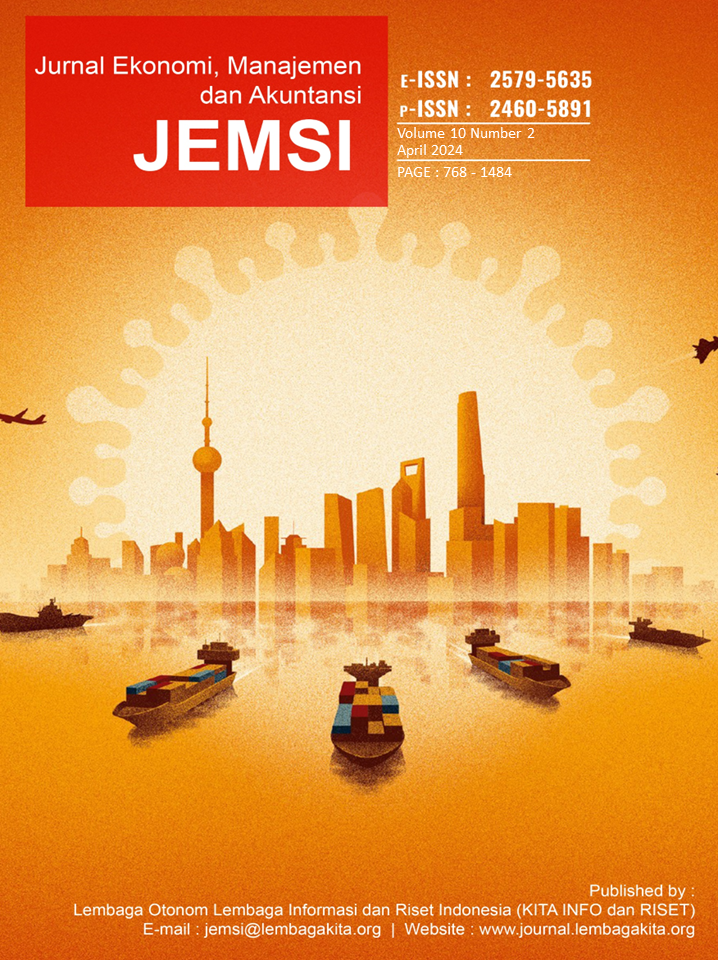Published: 2024-04-01
Analysis Of The Influence Of Digital Brand Perception And E-Wom On Repurchase Intention Of Internet Protocol Television Service Product
DOI: 10.35870/jemsi.v10i2.2252
Taat Kuspriyono, Silvia Ekasari, Arifai Ilyas, Donny Dharmawan, Musran Munizu
Article Metrics
- Views 0
- Downloads 0
- Scopus Citations
- Google Scholar
- Crossref Citations
- Semantic Scholar
- DataCite Metrics
-
If the link doesn't work, copy the DOI or article title for manual search (API Maintenance).
Abstract
The purpose of this study is to determine whether brand image and unfavorable electronic word-of-mouth factors have an impact on repurchase intentions. The study's population consists of social media users in a few Indonesian cities. With a sample size of 100 respondents, researchers employed a non-probability sampling method with a purposive sampling strategy. This study use questionnaires and literature reviews as data collection methods. Researchers employed quantitative techniques in this study. The path analysis method was applied by researchers. Based on the findings, it was determined that the negative electronic word-of-mouth variable had a direct impact on the brand image variable. The purchasing choice variable is directly impacted by the unfavorable electronic word-of-mouth variable. The repurchase intention variable is directly impacted by the brand image variable. Negative brand perception and electronic word-of-mouth have an impact on the repurchase intention variable. Via the brand image variable, the negative electronic word-of-mouth variable indirectly affects the repurchase intention variable. The aforementioned points provide an explanation for how brand image influences repurchase intentions when it comes to electronic word-of-mouth. It is intended that these findings would help the business sustain and improve electronic word-of-mouth on social media in the future.
Keywords
No keywords available.
Article Metadata
Peer Review Process
This article has undergone a double-blind peer review process to ensure quality and impartiality.
Indexing Information
Discover where this journal is indexed at our indexing page to understand its reach and credibility.
Open Science Badges
This journal supports transparency in research and encourages authors to meet criteria for Open Science Badges by sharing data, materials, or preregistered studies.
How to Cite
Article Information
This article has been peer-reviewed and published in the JEMSI (Jurnal Ekonomi, Manajemen, dan Akuntansi). The content is available under the terms of the Creative Commons Attribution 4.0 International License.
-
Issue: Vol. 10 No. 2 (2024)
-
Section: Articles
-
Published: %750 %e, %2024
-
License: CC BY 4.0
-
Copyright: © 2024 Authors
-
DOI: 10.35870/jemsi.v10i2.2252
AI Research Hub
This article is indexed and available through various AI-powered research tools and citation platforms. Our AI Research Hub ensures that scholarly work is discoverable, accessible, and easily integrated into the global research ecosystem. By leveraging artificial intelligence for indexing, recommendation, and citation analysis, we enhance the visibility and impact of published research.




No author biographies available.
-
-
-
-
-
-
-
-
-
-
Nurprihatin, F., & Tannady, H. (2018). An integrated transportation models and savings algorithm to minimize distribution costs. In Proceeding of the 1st Asia Pacific Conference on Research in Industrial and Systems Engineering (pp. 216-221). Depok: Department of Industrial Engineering Universitas Indonesia.
-
Authors who publish with this journal agree to the following terms:
1. Copyright Retention and Open Access License
Authors retain copyright of their work and grant the journal non-exclusive right of first publication under the Creative Commons Attribution 4.0 International License (CC BY 4.0).
This license allows unrestricted use, distribution, and reproduction in any medium, provided the original work is properly cited.
2. Rights Granted Under CC BY 4.0
Under this license, readers are free to:
- Share — copy and redistribute the material in any medium or format
- Adapt — remix, transform, and build upon the material for any purpose, including commercial use
- No additional restrictions — the licensor cannot revoke these freedoms as long as license terms are followed
3. Attribution Requirements
All uses must include:
- Proper citation of the original work
- Link to the Creative Commons license
- Indication if changes were made to the original work
- No suggestion that the licensor endorses the user or their use
4. Additional Distribution Rights
Authors may:
- Deposit the published version in institutional repositories
- Share through academic social networks
- Include in books, monographs, or other publications
- Post on personal or institutional websites
Requirement: All additional distributions must maintain the CC BY 4.0 license and proper attribution.
5. Self-Archiving and Pre-Print Sharing
Authors are encouraged to:
- Share pre-prints and post-prints online
- Deposit in subject-specific repositories (e.g., arXiv, bioRxiv)
- Engage in scholarly communication throughout the publication process
6. Open Access Commitment
This journal provides immediate open access to all content, supporting the global exchange of knowledge without financial, legal, or technical barriers.
